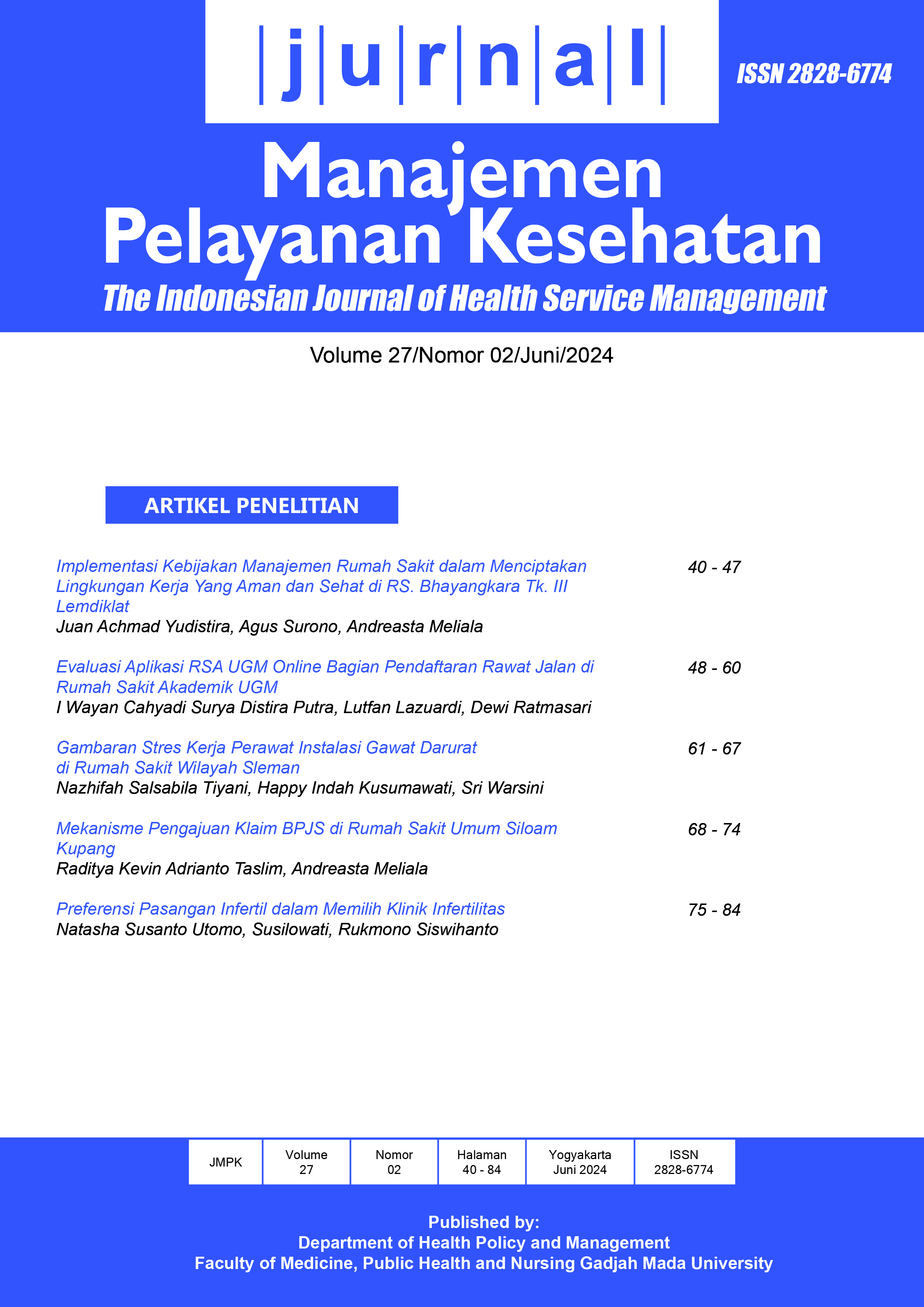EVALUASI APLIKASI RSA UGM ONLINE BAGIAN PENDAFTARAN RAWAT JALAN DI RUMAH SAKIT AKADEMIK UGM
EVALUATION OF THE UGM RSA ONLINE APPLICATION FOR OUTPATIENT REGISTRATION AT RUMAH SAKIT AKADEMIK UGM
Abstract
Background : Registration using the UGM RSA Online Application has been implemented at Rumah Sakit Akademik UGM since 2021. In practice, those who register via the application were 9% at the end of 2021 and increase to 25% in mid- 2022 of all outpatients visiting the hospital. Therefore research was conducted to see the implementation and evaluation of the UGM Online RSA Application.
Purposes : Implementation evaluates the application RSA UGM Online at Rumah Sakit Akademik UGM with the HOT Fit approach. That seeing from the human factor, technology, organization, and net benefits.
Methods : This research adopts and embedded design using mixed methods approach. Quantitative take precedence with the survey, following by in-depth interviews. Utilizing convenient and purposive sampling, this research was conducted at RSA UGM from 18th July 2022-12th August 2022.
Results : Surveys involved 42 patients and 28 employees, while in-depth interviews included 7 employees. The majority of patients and employees in the surveys strongly agreed or agreed with statements regarding Humans, Organizations, Technology, and Net Benefits in relation to the application’s implementation. The benefits included simplifying patient registration, reducing waiting times, predicting queues providing rapid information, supporting caring and friendly hospital services and reducing duplications, thereby reducing patients registration complaints. Obstacles included patients sometimes being unfamiliar with online registration (e.g. elderly), device compatibility issues with the application, outdated or inflexible interfaces, inappropriate doctor schedules, and lack of integration with other systems.
Conclusions : The RSA UGM Online Application reviewed through the dimension of human factors, organization, and technology, shows satisfactory alignment (fit) and offers beneficial health services. However, there are some obstacles that need to be addressed and further improvements to more increase the number of users.
References
Azeez, A. A. and Ajibola, A. (2019) ‘A Secured Medical Booking System Using Qr-Code Authentication’, International Journal of Scientific Research in Computer Science, Engineering and Information Technology, 5(6), pp. 305–311. doi: 10.32628/CSEIT195653.
Cao, W. et al. (2011) ‘A web-based appointment system to reduce waiting for outpatients: A retrospective study’, BMC Health Services Research. Available at: http://www.biomedcentral.com/1472-6963/11/318.
Chang, M. Y. et al. (2015) ‘Exploring user acceptance of an e-hospital service: An empirical study in Taiwan’, Computer Standards & Interfaces, 38, pp. 35–43. Available at: https://www.sciencedirect.com/science/article/pii/S0920548914000828.
Chin, W. . and Lee, M. K. . (2000) ‘A Proposed Model and Measurement Instrument for The Formation of IS Satisfaction’, pp. 553–563.
Clingan, S. A. (2011) ‘Going online: The role of web-based initiatives in health information technology’, J Med Pract Manage. Available at: https://pubmed.ncbi.nlm.nih.gov/21506462/.
Devi, F. Z. and Dewi, E. R. (2019) ‘STUDI EVALUASI SISTEM INFORMASI PENDAFTARAN DI RUMAH SAKIT UMUM DAERAH dr. LOEKMONO HADI KUDUS’, Jurnal Kesehatan Masyarakat. doi: doi.org/10.31596/jkm.v6i2.298.
Gefen, D., Karahanna, E. and Straub, D. W. (2003) ‘Trust and TAM in online shopping: an integrated model’, Management Information System, 27, pp. 51–90.
Gefen, D. and Keil, M. (1998) ‘The Impact of Developer Responsiveness on Perceptions of Usefulness and Ease of Use" An Extension of the Technology Acceptance Model’, The DATA BASE for Advances in Information Systems - Spring, 29.
Gücin, N. Ö. and Berk, Ö. S. (2015) ‘Technology Acceptance in Health Care: An Integrative Review of Predictive Factors and Intervention Programs’, Elsevier, pp. 1698–1704.
Halim, T. and Darma, G. S. (2019) ‘Faktor Penentu Kesuksesan Web-Based Appointment System di Rumah Sakit’, Jurnal Manajemen Bisnis, 16.
Hong, W. et al. (2001) ‘Determinants of user acceptance of digital libraries: an empirical examination of individual difference and system characteristics’, Management Information System, 18, pp. 97–124.
Hu, P. J. et al. (1999) ‘Examining the technology acceptance model using physician acceptance of telemedicine technology’, Management Information System, 16, pp. 195–204.
Igbaria, M. et al. (1997) ‘Personal Computing Acceptance Factors in Small Firms: A Structural Equation Model1’, Management Information Systems Research Center, pp. 279–305.
Jackson, C. M., Chow, S. and Leitch, R. (1997) ‘Toward an Understanding of the Behavioral Intention to Use an Information System’, Decision Sciences, 28.
Jones, R. et al. (2010) ‘eTriage – a novel, web-based triage and booking service: enabling timely access to sexual health clinics’, International Journal of STD and AIDS, 21.
Khotimah, A. (2017) ‘Evaluasi Sistem Informasi Manajemen Rumah Sakit Rajawali Citra Yogyakarta Menggunakan Model Human Organization Technology Fit (HOT-FIT)’.
Kurniawati, Y. D., Djasri, H. and Utarini, A. (2021) ‘Dampak Implementasi Aplikasi Pendaftran Daring Pelayanan Rawat Jalan Rumah Sakit’, Jurnal Manajmen Pelayanan Kesehatan, 24, pp. 48–54.
PC, T. et al. (2003) ‘PAMFOnline: integrating EHealth with an electronic medical record system’.
Pujianto, H. and Muqorubin (2020) ‘Analysis of “E-Patient UNS” Application System for Online Registration of UNS Hospital Patients’, Internation Journal of Computer and Information System (IJCIS), 02(01). Available at: https://ijcis.net/index.php/ijcis/index.
Purba, E. L. (2007) Akseptansi dan Kepuasan Pengguna Sistem Informasi Rumah Sakit (SIRS) di Rumah Sakit Umum Daerah (RSUD) Pematangsiantar. Universitas Gadjah Mada.
Puspitasari, E. R. (2018) Evaluasi Implementasi Sistem Informasi Manajemen Rumah Sakit di RSUD Kabupaten Temanggung dengan metode HOT FIT. Universitas Gadjah Mada.
Sastroasmoro, S. and Ismael, S. (2014) Dasar Dasar Metodologi Penelitian Klinis. 5th edn. Jakarta: Sagung Seto.
Siddiqui, Z. and Rashid (2013) ‘Cancellations and patient access to physicians: ZocDoc and the evolution of e-medicine’, Dermatology Onlinie J. Available at: https://pubmed.ncbi.nlm.nih.gov/24021373/.
Supriyono (2016) ‘Evaluasi Sistem Informasi Manajemen Rumah Sakit Dengan Metode Hot Fit Di Rumah Sakit Umum Daerah Raden Mattaher Jambi’, Journal of Information Systems for Public Health, 2.
Thompson, N. et al. (2011) ‘The Digital Divide at an Urban Community Health Center: Implications for Quality Improvement and Health Care Access’, J Community Health. doi: 10.1007/s10900-010-9327-5.
Utarini, A. (2020) Tak Kenal Maka Tak Sayang. 1st edn. UGM PRESS.
Venkatesh, V. and Davis, D. F. (2000) ‘A Theoretical Extension of the Technology Acceptance Model: Four Longitudinal Field Studies’, Management Science, 46, pp. 186–204. doi: 10.1287/mnsc.46.2.186.11926.
Yusof, M. M. (2006) ‘Towards a Framework for Health Information Systems Evaluation’, in. Uxbridge: Hawaii International Conference on System Science.
Yusof, M. M. (2015) ‘A case study evaluation of a Critical Care Information System adoption using the socio-technical and fit approach’, International Journal of Medical Informatics, pp. 486–499.
Zhang, M. et al. (2014) ‘Questionnaire survey about use of an online appointment booking system in one large tertiary public hospital outpatient service center in China’, BMC Medical Informatics and Decision Making. Available at: http://www.biomedcentral.com/1472-6947/14/49.
Zhang, X. et al. (2012) ‘Patients’ perceptions of web self-service applications in primary healthcare’, Stud Health Technol Inform, pp. 242–249. doi: 10.3233/978-1-61499-078-9-242.
Zhang, X. et al. (2015) ‘Using diffusion of innovation theory to understand the factors impacting patient acceptance and use of consumer e-health innovations: a case study in a primary care clinic’, BMC Health Services Research. doi: 10.1186/s12913-015-0726-2.
Zhao, P. et al. (2017) ‘Web-Based Medical Appointment Systems: A Systematic Review’, Journal of Medical Internet Research. Available at: https://www.ncbi.nlm.nih.gov/pmc/articles/PMC5425771/?report=printable.
Copyright (c) 2024 I Wayan Cahyadi Surya Distira Putra, Lutfan Lazuardi , Dewi Ratmasari

This work is licensed under a Creative Commons Attribution-NonCommercial-ShareAlike 4.0 International License.




